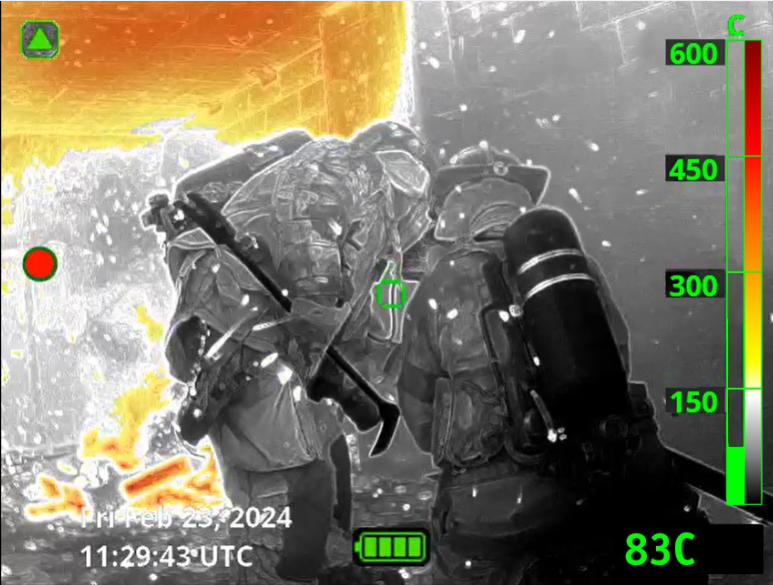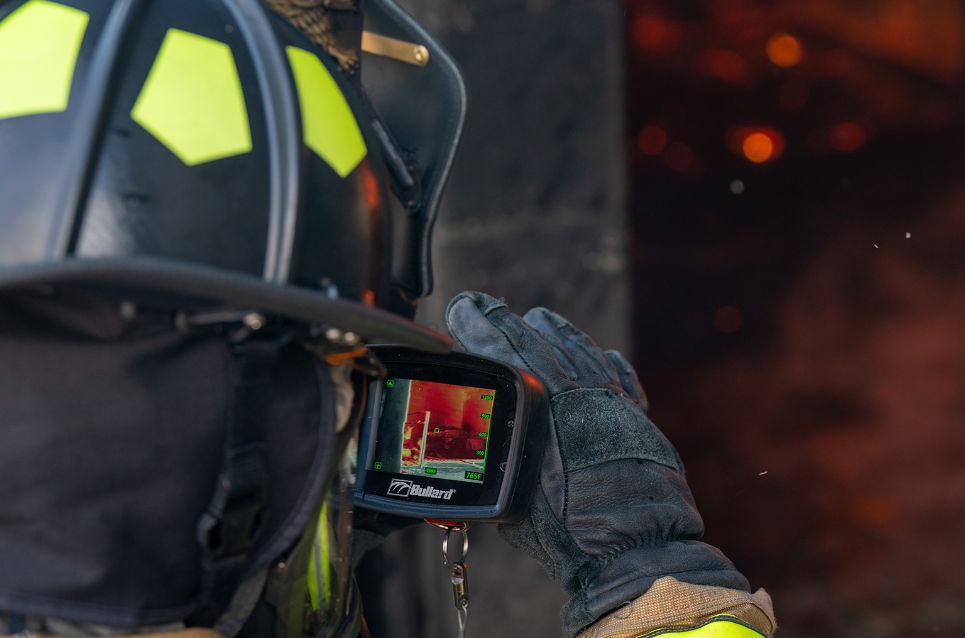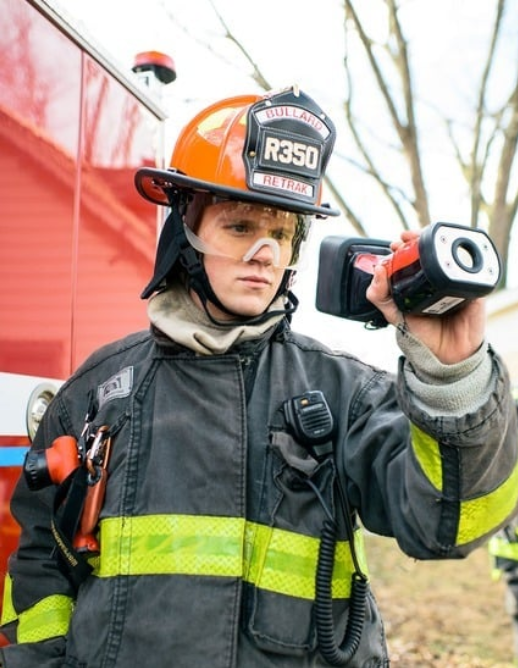Familiarizing yourself with key thermal imager terminology can provide a better understanding of the features and benefits of thermal imagers for enhanced safety and performance in the field.
High-Heat Colorization
The process of adding color to thermal images to highlight specific temperature ranges, commonly used to indicate the hottest areas (e.g., red for extreme heat).
Contrast
The difference in brightness between areas of different temperatures in a thermal image. High contrast enhances visibility of details in the image.
Core
The core typically includes the infrared sensor itself, along with necessary electronics for signal processing and amplification
Detector
(See Focal Plane Array)
Durability
The ability of a thermal imager to withstand the rigors of typical firefighting activities such as extreme environmental temperatures, high heat exposures, impact, and exposure to water.
Dynamic Range
The span of temperatures a thermal imager can detect and display within a single image, from very cold to extremely hot environments.
Emissivity
The ratio of the energy radiated from a material’s surface to that of a blackbody, or perfect emitter/absorber, at the same temperature. Thus if a surface absorbs 85% of the radiant energy that reaches it, the absorption coefficient (emissivity) is 0.85.
Field of View (FOV)
The width and height of the area a thermal imager can capture or visualize at a given distance. A wider FOV results in more scene elements being visible on the thermal imager display.
Focal Plane Array (FPA)
Often referred to as the Sensor or Detector, a Focal Plane Array is a sensor that detects light or other radiation, including infrared radiation, and converts it into electronic signals for image processing.
Gain Level
The automatic adjustment of a thermal imager’s sensitivity based on the amount of thermal energy in a scene. Fire service thermal imagers typically have high gain (normal) and low gain levels. High gain is used to make the core more sensitive for use in lower temperature situations while low gain is used to lower sensitivity for use in high temperature situations.
Heat Signature
The thermal pattern emitted by an object, person, or area, visible through a thermal imager.
Infrared Radiation
A type of electromagnetic energy, that has a longer wavelength than visible light, typically in the range of 7.5-14 microns, but a shorter wavelength than microwaves and is emitted by all objects based on their temperature. Thermal imagers detect this radiation to create an image.
Ingress Protection (IP) Rating
A standardized rating system indicating a thermal imager’s resistance to dust and water. For example, IP67 means the device is dust-tight and can withstand immersion in water up to a set time and depth limit – typically 1 meter and 30 minutes.
Microbolometer
Type of an infrared detector used in thermal imagers that translates thermal energy into electrical signals for image processing. Commonly made of vanadium oxide or amorphous silicon.
NFPA Compliance
Indicates that a thermal imager meets the design and performance requirements of National Fire Protection Association (NFPA) standards on performance, durability, and safety in firefighting applications.
Noise Equivalent Temperature Difference (NETD)
The smallest temperature differences a thermal camera can detect between two objects, essentially measuring the sensitivity of the camera; a lower NETD value indicates a more sensitive camera, meaning it can distinguish smaller temperature variations in an image, while a higher NETD signifies poorer sensitivity and difficulty in seeing subtle temperature difference
Non-uniformity correction (NUC)
A calibration process that involves momentarily closing an internal shutter and improves the accuracy of thermal images by adjusting for minor variations in heat.
Operational Temperature Range
The internal temperature range within which the thermal imager operates correctly, typically -40°F to 185°F for fire service models.
Pixels – Display
The independent squares of light that make up the image represented on the thermal imager display. The number and size of pixels determine the resolution and play a role in the overall image quality. Display pixel count should exceed the core pixel count for best image quality.
Pixels – Core
The independent squares on an infrared detector that sense thermal energy. The number and size of pixels determine the resolution and play a role in the overall image quality.
Refresh Rate – Display
Different that the Refresh Rate of the core, the display refresh rate is the speed, typically given in frames per second (FPS) or Hertz (Hz), at which the image on the thermal imager’s screen updates). The higher the rate, the smoother the image presents on the display.
Refresh Rate – Core
Different that the Refresh Rate of the display, the core refresh rate is the speed, typically given in frames per second (FPS) or Hertz (Hz), at which the core (Focal Plane Array and read out electronics) converts collected radiation into electronic signals for image processing.
Resolution – Core
The number of pixels in the focal plane array that are used to capture thermal radiation from the environment. Higher resolution (e.g., 640×480 pixels) provides greater detail and higher image quality but can increase the cost of the imager.
Resolution – Display
The number of pixels used to display a thermal image to the end user.
Saturation
The state where a thermal imager’s sensor reaches its maximum capacity to receive and/or process thermal energy often resulting in opacity of the image in the area of saturation. This opacity may show as white, in imagers not equipped with high-heat colorization, or as the color of the highest temperature used by a particular manufacturer. Older thermal technology would saturate across the entire focal plane array and was often referred to as “white out.“; however, modern thermal imagers no longer experience this phenomenon.
Shutter
Used in the process of Non-Uniformity Correction, the closing of the shutter causes the image on a microbolometer to briefly “freezes ” so the imager can recalibrate and maintain accuracy. This is normal for all fire service microbolometers.
Spatial Resolution
Characterizes the ability of devices to show two closely located points or lines separately.
Spot Temperature Measurement
A feature that displays the approximate temperature of a specific point in the thermal image, aiding in heat detection and evaluation.
Temperature Range
(see Dynamic Range)
Thermal Imager
A device that detects infrared radiation to produce images based on temperature differences.
Thermal Sensitivity
(see Noise Equivalent Temperature Difference (NETD))
Thermal Throttle
A feature that enhances image contrast by dynamically adjusting sensitivity to highlight specific temperature ranges.
White Out
A term describing older thermal imaging technology’s inability to process intense heat, leading to an all-white display. Modern thermal imagers are immune to this issue.
Not sure where to get started? Contact a Bullard expert here.



